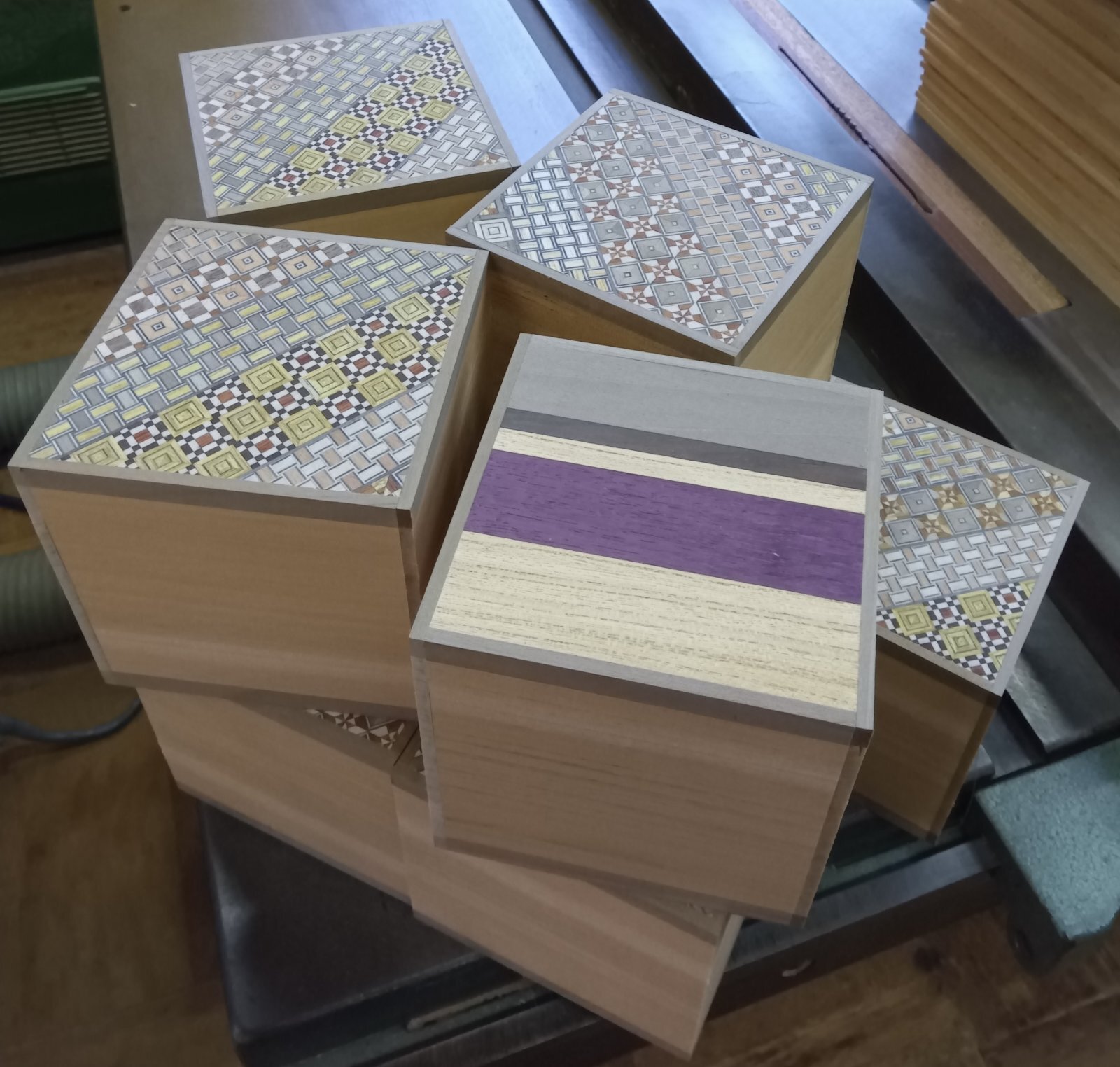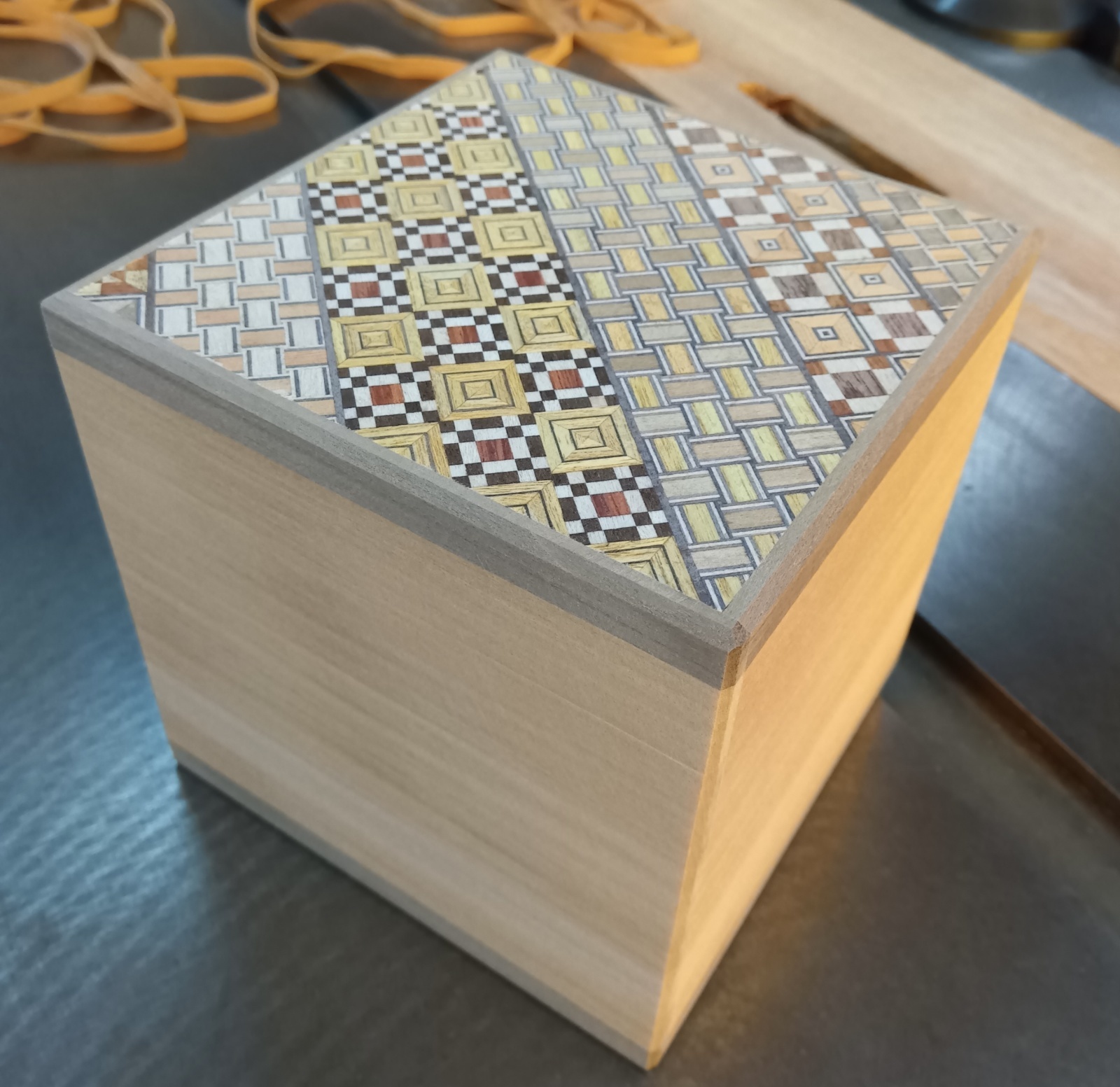4 sun cube box (3)
Today, I'm mainly working on finishing the 4-sun cube Himitsubako and making progress on the 4-sun 27-step Himitsubako. The photo shows the 4-sun cube box before the base coat of paint. The weather has been great since this morning, with very low humidity, making it an ideal condition for working on Himitsubako. However, I'm a bit concerned because the wood is still releasing moisture from the high humidity a few days ago. Since the unpainted box is very delicate and also releases moisture, gaps can easily form between the box panels and the main body. Therefore, I need to move quickly to the painting process. This 4-sun cube box was also assembled during a humid period. I reduced the humidity in the workspace with the air conditioner before assembling it, but today’s low humidity (excellent drying conditions) is having a slight impact.
The design of this 4-sun cube box turned out as shown in the photo. The top and bottom surfaces feature traditional yosegi, while the side panels are made of Agathis wood. and there is one box with a natural wood design.
Additionally, the top and bottom edges of the Agathis panels are bordered with Hoo wood. It's a simple design, but I had a hard time aligning the borders on the top and bottom surfaces.
The side panels have four surfaces, but to match the dimensions of the Aruki panels (Moving panels) on the two fixed sides, I need to make the Aruki panels about 3mm wider. This is because the Aruki panels have the "kannuki" (slide key), and when making it, I use a saw. The thickness of the saw blade causes some of the wood to be shaved off, making the Aruki panels smaller than intended.
The saw I use has a thickness of 1.3mm. Since the saw cuts through both sides of the "kanuki," I make the Aruki panels about 3mm wider from the start. It's not 2.6mm but 3mm. This is because if the Aruki panel becomes smaller than the dimensions of the fixed panels during the process of making the "kannuki," I can't add any material back. Therefore, I intentionally make the Aruki panels larger than needed so that, even after making the "kannuki," there is still some extra width. Then, I gradually shave it down until it matches the dimensions of the fixed side panels.
This time, the process required extra effort because this box has edging on both the top and bottom of the side panels. I had to ensure that the dimensions of both the top and bottom edging matched perfectly. If there were only edging on the top side, it wouldn't be as challenging. That's why many of the boxes I've made so far have edging only on the top side😄
The design of this 4-sun cube box turned out as shown in the photo. The top and bottom surfaces feature traditional yosegi, while the side panels are made of Agathis wood. and there is one box with a natural wood design.
Additionally, the top and bottom edges of the Agathis panels are bordered with Hoo wood. It's a simple design, but I had a hard time aligning the borders on the top and bottom surfaces.
The side panels have four surfaces, but to match the dimensions of the Aruki panels (Moving panels) on the two fixed sides, I need to make the Aruki panels about 3mm wider. This is because the Aruki panels have the "kannuki" (slide key), and when making it, I use a saw. The thickness of the saw blade causes some of the wood to be shaved off, making the Aruki panels smaller than intended.
The saw I use has a thickness of 1.3mm. Since the saw cuts through both sides of the "kanuki," I make the Aruki panels about 3mm wider from the start. It's not 2.6mm but 3mm. This is because if the Aruki panel becomes smaller than the dimensions of the fixed panels during the process of making the "kannuki," I can't add any material back. Therefore, I intentionally make the Aruki panels larger than needed so that, even after making the "kannuki," there is still some extra width. Then, I gradually shave it down until it matches the dimensions of the fixed side panels.
This time, the process required extra effort because this box has edging on both the top and bottom of the side panels. I had to ensure that the dimensions of both the top and bottom edging matched perfectly. If there were only edging on the top side, it wouldn't be as challenging. That's why many of the boxes I've made so far have edging only on the top side😄

